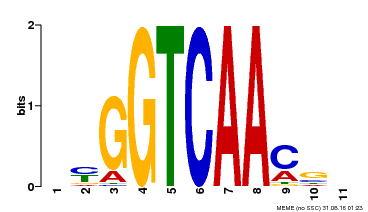- Eulgem T,Rushton PJ,Robatzek S,Somssich IE
The WRKY superfamily of plant transcription factors.
Trends Plant Sci., 2000. 5(5): p. 199-206
[PMID:10785665] - Riechmann JL, et al.
Arabidopsis transcription factors: genome-wide comparative analysis among eukaryotes.
Science, 2000. 290(5499): p. 2105-10
[PMID:11118137] - Chen C,Chen Z
Potentiation of developmentally regulated plant defense response by AtWRKY18, a pathogen-induced Arabidopsis transcription factor.
Plant Physiol., 2002. 129(2): p. 706-16
[PMID:12068113] - Dong J,Chen C,Chen Z
Expression profiles of the Arabidopsis WRKY gene superfamily during plant defense response.
Plant Mol. Biol., 2003. 51(1): p. 21-37
[PMID:12602888] - Yamada K, et al.
Empirical analysis of transcriptional activity in the Arabidopsis genome.
Science, 2003. 302(5646): p. 842-6
[PMID:14593172] - Hoth S, et al.
Monitoring genome-wide changes in gene expression in response to endogenous cytokinin reveals targets in Arabidopsis thaliana.
FEBS Lett., 2003. 554(3): p. 373-80
[PMID:14623097] - Li J,Brader G,Palva ET
The WRKY70 transcription factor: a node of convergence for jasmonate-mediated and salicylate-mediated signals in plant defense.
Plant Cell, 2004. 16(2): p. 319-31
[PMID:14742872] - Goda H, et al.
Comprehensive comparison of auxin-regulated and brassinosteroid-regulated genes in Arabidopsis.
Plant Physiol., 2004. 134(4): p. 1555-73
[PMID:15047898] - Ma S,Quist TM,Ulanov A,Joly R,Bohnert HJ
Loss of TIP1;1 aquaporin in Arabidopsis leads to cell and plant death.
Plant J., 2004. 40(6): p. 845-59
[PMID:15584951] - Nagata T,Yamada H,Du Z,Todoriki S,Kikuchi S
Microarray analysis of genes that respond to gamma-irradiation in Arabidopsis.
J. Agric. Food Chem., 2005. 53(4): p. 1022-30
[PMID:15713015] - Duarte JM, et al.
Expression pattern shifts following duplication indicative of subfunctionalization and neofunctionalization in regulatory genes of Arabidopsis.
Mol. Biol. Evol., 2006. 23(2): p. 469-78
[PMID:16280546] - Truman W,de Zabala MT,Grant M
Type III effectors orchestrate a complex interplay between transcriptional networks to modify basal defence responses during pathogenesis and resistance.
Plant J., 2006. 46(1): p. 14-33
[PMID:16553893] - Xu X,Chen C,Fan B,Chen Z
Physical and functional interactions between pathogen-induced Arabidopsis WRKY18, WRKY40, and WRKY60 transcription factors.
Plant Cell, 2006. 18(5): p. 1310-26
[PMID:16603654] - Tosti N, et al.
Gene expression profiles of O3-treated Arabidopsis plants.
Plant Cell Environ., 2006. 29(9): p. 1686-702
[PMID:16913859] - Ascencio-Ib
Global analysis of Arabidopsis gene expression uncovers a complex array of changes impacting pathogen response and cell cycle during geminivirus infection.
Plant Physiol., 2008. 148(1): p. 436-54
[PMID:18650403] - Peng Y, et al.
OsWRKY62 is a negative regulator of basal and Xa21-mediated defense against Xanthomonas oryzae pv. oryzae in rice.
Mol Plant, 2008. 1(3): p. 446-58
[PMID:19825552] - Shang Y, et al.
The Mg-chelatase H subunit of Arabidopsis antagonizes a group of WRKY transcription repressors to relieve ABA-responsive genes of inhibition.
Plant Cell, 2010. 22(6): p. 1909-35
[PMID:20543028] - Chen H, et al.
Roles of arabidopsis WRKY18, WRKY40 and WRKY60 transcription factors in plant responses to abscisic acid and abiotic stress.
BMC Plant Biol., 2010. 10: p. 281
[PMID:21167067] - Arabidopsis Interactome Mapping Consortium
Evidence for network evolution in an Arabidopsis interactome map.
Science, 2011. 333(6042): p. 601-7
[PMID:21798944] - Wenke K, et al.
Volatiles of two growth-inhibiting rhizobacteria commonly engage AtWRKY18 function.
Plant J., 2012. 70(3): p. 445-59
[PMID:22188129] - Liu ZQ, et al.
Cooperation of three WRKY-domain transcription factors WRKY18, WRKY40, and WRKY60 in repressing two ABA-responsive genes ABI4 and ABI5 in Arabidopsis.
J. Exp. Bot., 2012. 63(18): p. 6371-92
[PMID:23095997] - Koyama T, et al.
A regulatory cascade involving class II ETHYLENE RESPONSE FACTOR transcriptional repressors operates in the progression of leaf senescence.
Plant Physiol., 2013. 162(2): p. 991-1005
[PMID:23629833] - Ding Y, et al.
Four distinct types of dehydration stress memory genes in Arabidopsis thaliana.
BMC Plant Biol., 2013. 13: p. 229
[PMID:24377444] - Zhang Y, et al.
Regulation of oncogene expression in T-DNA-transformed host plant cells.
PLoS Pathog., 2015. 11(1): p. e1004620
[PMID:25615824] - Geilen K,Böhmer M
Dynamic subnuclear relocalisation of WRKY40 in response to Abscisic acid in Arabidopsis thaliana.
Sci Rep, 2015. 5: p. 13369
[PMID:26293691] - Geilen K,Böhmer M
Dynamic subnuclear relocalization of WRKY40, a potential new mechanism of ABA-dependent transcription factor regulation.
Plant Signal Behav, 2015. 10(11): p. e1106659
[PMID:26479147] - Lu K, et al.
Overexpression of an Arabidopsis cysteine-rich receptor-like protein kinase, CRK5, enhances abscisic acid sensitivity and confers drought tolerance.
J. Exp. Bot., 2016. 67(17): p. 5009-27
[PMID:27406784]
|





